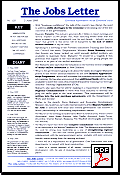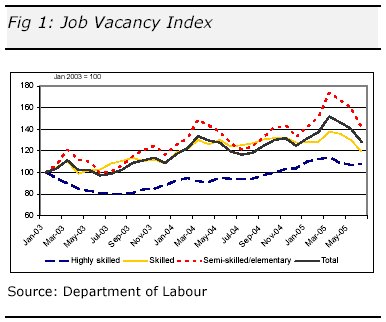



|
 |

|
| No.237 | 18 August 2005 | Essential Information on an Essential Issue |
of key events over the last few weeks. LOWEST UNEMPLOYMENT IN OECD THE SOCIAL REPORT 2005 PARTIES CAMPAIGN ON WORK-FOR-THE-DOLE YOUNG PEOPLE'S INDUSTRY TRAINING SCHEMES EXTENDED LABOUR TO SCRUB STUDENT LOAN INTEREST FOR RESIDENTS PRISON INMATES GET WINZ CASE MANAGERS WORK TESTING FOR HOME DETAINEES WINZ REGIONAL PLANS CHILD-IMPACT REPORTING NATS ANNOUNCE MIGRANT POLICIES RETAINING OLDER WORKERS OZ CONFERENCE FOR FULL EMPLOYMENT  LAST Letter
LAST Letter
NEXT Letter   Download this issue as a PDF file
Index to Features
20 July 2005The average pay rise for NZ workers was 2.8% over the last year, according to a Victoria University survey. The rate was higher than the 2.2% average annual wage rise over the last 14 years. The survey also found that the lowest paid NZers had the lowest proportional pay rise. 21 July 2005An action group is set up in Blenheim to help combat the region's vineyard labour shortage. It will investigate measures to clean up the industry, including transparency of pricing, promoting the area to attract workers, and developing a template of employers' obligations. More than half of Australian companies in the building industry say that recruitment and retention of skilled workforce is their greatest challenge. 24 July 2005Unemployment in Zimbabwe is above 70% and inflation in triple digits. The economy has contracted by more than 30% since 1999 when the government redistributed the country's commercial farms. The situation is exacerbated this year by the government demolishing urban housing and commercial neighbourhoods that has left 700,000 people homeless and a further 2.4 million people without livelihoods. 25 July 200530 jobs are lost in Takaka as Fonterra decides to only rebuild part of its plant that was badly damaged by fire earlier this year. Kimberly-Clark, maker of Huggies nappies and Kleenex tissues, will cut 6,000 jobs and sell 20 of its US and European factories. 27 July 200547 mayors have signed up as supporters of the Every Child Counts campaign. Carter Holt Harvey's Tokoroa plywood mill will cut 55 workers from its staff as material costs rise and Australian sales decline. 28 July 2005The Motor Industry Training Organisation signs up its 4,000th Modern Apprentice. "The New Zealand legend" Swanndri, wool clothing manufacturer, will close its Timaru plant and begin manufacturing in China from next year. Chief executive Julian Bowden says it is not economic to upgrade the Timaru mill. 29 July 2005A record number of 77,880 skilled migrants were admitted to Australia over the last year. The Australian government has set a target of attracting 100,000 skilled migrants and their families this year. Sydney immigration lawyer Mark Tarrant says NZ immigration regulations should be more flexible if we want to encourage more skilled migrants. He suggests NZ lowers the English language requirement and recognize qualifications from a broader range of countries. 1 August 2005The NZ Nurses Organisation says it is no wonder there are such serious recruitment and retention problems in the aged care sector when the pay rates of aged care workers are "a disgrace". Age care co-ordinator Cee Payne-Harker says that some parties are seeking political mileage from attacking the government's record in aged care while failing to provide any policy detail and firm funding commitments about how they will fix the problem. NZNO is challenging all political parties to demonstrate how they will ensure a decent standard of care for our older people and how they will ensure the workforce in aged care is fairly paid, adequately trained and maintained at an appropriate staffing level. Minimum award rates for Australian workers in the home care sector range from $14.97/hr to $16.53/hr. The Child Poverty Action Group says that the 300,000 children in NZ growing up in poverty places NZ near the bottom of the OECD's child poverty table. CPAG is holding a seminar that will outline the current situation of the health and well-being of NZ children and young people and will look at current policy and ways in which improvements may be made. The seminar will be held on 26 September, at University of Auckland. Cost: $22/$12 (student/unwaged). To enrol phone: 09 373 7599 ext 87832. Meat processing company CMP Rangitikei advertises for 65 new employees for a new night shift at its Greatford plant. 2 August 2005500 jobs will be lost as alloy wheel manufacturer Ion Automotive in Wiri, South Auckland begins to shut up shop. English language school tuition fees have dropped by as much as two-thirds, as schools battle each other and foreign competitors for a share of the international English language student market. Fees are down to as low as $90/wk from about $230/wk. The number of Chinese students studying in NZ dropped 37% over the year. Japanese students are now more numerous in NZ than those from China. 3 August 2005Bay of Plenty economic development organisation Priority One is among a number of local body agencies, recruitment companies and short-staffed NZ businesses and who will attend job expos in Bonn and Berlin. They will be setting up stalls with the intention or hiring skilled Germans to shift to NZ to work. Priority One CEO Ross Stanway says going to the German expos is part of the solution to skills shortages. Secondary schools are being forced to look overseas for science and maths teachers. Wellington College principal Roger Moses has just returned from London where he has interviewed and hired a number of English and ex-pat NZers to fill physics, chemistry and maths jobs. He says a lack of quality staff in these subjects is worrying. 6 August 2005One-quarter of NZ school principals have resigned in the past three years, partly because the job is intolerably stressful, according to the Principal's Federation. 14% of principals are believed to be currently on stress leave and nationwide survey revealed 40% of principals are highly or extremely stressed. 9 August 2005The University of Waikato will cut 30 jobs as it faces its first fiscal deficit ever. Qantas Airways is to cut 200 management jobs. 10 August 2005More than half the seasonal workers placed in horticulture and viticulture jobs in Central Otago by Seasonal Solutions were foreigners. Spokesperson Basil Goodman says 56% of the 2,135 workers placed were from overseas, mainly from the Czech Republic, Britain, Germany and Israel. 11 August 2005The Australian economy created 12,700 jobs last month, the 11th consecutive month of job expansion. The economy has created 374,100 jobs over the year bringing the Australian workforce to 10.5 million people. 12 August 2005David Lange, former Prime Minister and statesman, dies. The axing of the Holmes show from Prime TV sees 14 of the 30 staff lose their jobs. 13 August 2005Up to 45 forestry jobs are lost in Rotorua as Kaingaroa Timberlands cuts back its harvesting levels. The job losses will be split between the company and two contracting crews. 14 August 2005More than 400 new teachers will be hired to work in intermediate and secondary classrooms in a bid to drive down the student to teacher ratio. Over one-third of classrooms have more than 25 students to teacher and 10% have more than 30 students. Ministry of Education aims at a standard of 23.5 students per teacher. KEA, the NZ expatriate association, aims to seize the opportunities presented by the 500,000 New Zealanders living and working outside the country. KEA works like a global alumni network to link small and early-stage export businesses with the skills and knowledge of overseas NZers. Contact KEA at www.kiwiexpat.org.nz/ Australian opposition leader Kim Beazley would establish a central unit to engage with the 900,000 Australian (almost 10% of the country's workforce) who live overseas. Beazley calls the diaspora "gold-collar workers" and the government should work harder to capitalize on their links to trade, investment and overseas cultures — and "perhaps encourage a few more to come home". 15 August 2005The Timaru Herald asks if the economic tide has started to turn, after a spate of redundancies in South Canterbury.
 LAST Diary
LAST Diary
NEXT Diary 
|
LOWEST UNEMPLOYMENT IN OECDThe fall unemployment was due to both a drop in the number of people who were unemployed and a rise in the number of people in jobs. Statistics New Zealand says the gradual slowing in the growth rate of the working-age population, combined with the economy persistently adding jobs, indicates that employers are continuing to find it difficult to hire all the staff they need. Annually, the proportion of jobs added to the economy remained a strong 3%. With 2,065,000 people in work, the New Zealand workforce is the largest it has ever been. We include our regular Statistics That Matter summary in this issue of The Jobs Letter. Some highlights: — full-time employment grew by 3.4%, while part-time employment grew by 2.0% over the year, — the rise in employment was driven primarily by more women in full-time work; over the year there was 4.9% growth in the number of women in full-time work, compared to 1.5% for men, — annually, unemployment fell by 7,000 women (down 16.2%) and by 1,000 men (down 3.3%), — the number of people long-term unemployed (out of work for more than six months) dropped from 15,000 to 13,500. Source - Statistics NZ Household Labour Force Survey June 2005 quarter commentary.
INDEX INDICATES SLOWING JOB GROWTHThe slowdown of growth of job vacancy ads was driven by a decline in the number of skilled vacancies, especially in the trades. There was a downturn (-11% for the year) in ads for trades staff. This was led by a sharp decline (-27%) in the number of vacancies in the building trades. This probably reflects the slowing of activity in residential construction and may suggest an improvement in recruitment conditions for employers. The Department is predicting employment growth will slow from 3.4% in the year to March 2005 to 1.2% in the next 12 months. Despite this, the Department says the labour market is still extremely strong and expects the unemployment rate to remain at 4% or slightly below for the next two years. — The Job Vacancy Monitor — June 2005, published by the Department of Labour, can be downloaded (4pg 148Kb) from here. 
THE SOCIAL REPORT 2005
PARTIES CAMPAIGN ON WORK-FOR-THE-DOLECollins says the work undertaken should not compete with the private sector and would have to be meaningful, like tree planting and removing graffiti. She says a great example is Papakura's town centre "ambassadors" who patrol the streets to catch shoplifters and kids wagging school, and minding cars parked at the railway station. Source - New Zealand Herald, 25 July 2005, "Work for dole in six months — National" by Simon Collins; Dominion Post, 26 July 2005, "Work-for-dole schemes come under fire by Anna Saunders and NZPA; Media release, CPAG, 27 July 2005, "Child advocates warn of destructive effect of `work for dole'"; Media release Green Party Sue Bradford, 25 July 2005, "Disgraceful work-for-the-dole doesn't work: Bradford"; Dominion Post, 13 August 2005 "United supports dole work".
YOUNG PEOPLE'S INDUSTRY TRAINING SCHEMES EXTEND The Labour Party pledges to fund 5,000 more Modern Apprenticeship training places.
Labour has pushed up the current target of having 9,000 Modern apprentices in training by the end of 2006
to having 14,000 people in the training scheme by the end of 2008. The government will also be
loosening up of the entry criteria for Modern Apprenticeship scheme by allowing up to a fifth of Modern
Apprenticeships to be available to people over 21 years. When full, the enlarged scheme will cost $17
million more per year. About 40% of this amount will come from savings the government says it will make
from cutting some tertiary certificate and diploma courses. The rest will be new spending. The Labour Party pledges to fund 5,000 more Modern Apprenticeship training places.
Labour has pushed up the current target of having 9,000 Modern apprentices in training by the end of 2006
to having 14,000 people in the training scheme by the end of 2008. The government will also be
loosening up of the entry criteria for Modern Apprenticeship scheme by allowing up to a fifth of Modern
Apprenticeships to be available to people over 21 years. When full, the enlarged scheme will cost $17
million more per year. About 40% of this amount will come from savings the government says it will make
from cutting some tertiary certificate and diploma courses. The rest will be new spending.
Clark also announced a Youth Apprenticeship pilot that is intended to provide the opportunity for young people to gain credits towards an apprenticeship while still at school. Source _ New Zealand Herald, 29 July 2005, "Clark finds cash for 5000 more apprentices" by Kevin Taylor; Dominion Post, 29 July 2005, "Apprenticeship changes win seal of approval" by Chalpat Sonti; Media released NZ government speech by Helen Clark, 28 July 2005, "PM: address to Industry Training Federation; Media release, Industry Training Federation, 28 July 2005, "Increasing momentum in industry training".
LABOUR TO SCRUB STUDENT LOAN INTEREST FOR RESIDENTS The government intends to wipe the interest on student loans for people who remain in
New Zealand rather than going overseas to work. The move would see a dramatic cut in the size and
repayment time of student loans. Prime Minister Helen Clark says all student loan scheme borrowers
— regardless of how much they earn, the condition of their loan, or the size of their debt — would
be better off if they stay in New Zealand. Clark: "This will help to retain the highly skilled and
well-educated pool of young Kiwis which our country needs to continue to grow and prosper." The government intends to wipe the interest on student loans for people who remain in
New Zealand rather than going overseas to work. The move would see a dramatic cut in the size and
repayment time of student loans. Prime Minister Helen Clark says all student loan scheme borrowers
— regardless of how much they earn, the condition of their loan, or the size of their debt — would
be better off if they stay in New Zealand. Clark: "This will help to retain the highly skilled and
well-educated pool of young Kiwis which our country needs to continue to grow and prosper."
About 460,000 — roughly one-in-six adults — owe a total of $6.9 billion in student loans and interest. The Labour Party has costed the interest write-off at $100 million for the first year, rising to $300 million annually. Source _ The Dominion Post, 27 July 2005, "Labour's bid to plug brain drain " by Haydon Dewes and Michelle Quirke; New Zealand Herald, 1 August 2005, "Struggling to keep the best and brightest" by Stuart Dye
PRISON INMATES GET WINZ CASE MANAGERS In an effort to reduce reoffending, the government is assigning a Work & Income Case
Manager and Work Broker to every prison, to help prisoners find work when they are released. Prior to
release, the Case Manager will complete skills assessments with inmates, identify employment opportunities
and match inmates to job opportunities in the region they are returning to. The Work & Income staff
will also work with the Correction Department's newly appointed "reintegration workers", whose task it
is to help prisoners rejoin the community more successfully. In an effort to reduce reoffending, the government is assigning a Work & Income Case
Manager and Work Broker to every prison, to help prisoners find work when they are released. Prior to
release, the Case Manager will complete skills assessments with inmates, identify employment opportunities
and match inmates to job opportunities in the region they are returning to. The Work & Income staff
will also work with the Correction Department's newly appointed "reintegration workers", whose task it
is to help prisoners rejoin the community more successfully.
Associate Minister of Social Development Rick Barker points out that even though the unemployment rate is under 4% and employers are experiencing labour shortages, former prisoners are still struggling to find work. Barker: "Employment must be seen as a part of the integration process back in to society. Inmates who leave prison and find work have a much better chance of staying out of trouble." Source - 1 August 2005, NZ government media release by Paul Swain and Rick Bark, "Prisoner Reintegration Initiative".
WORK TESTING FOR HOME DETAINEESSource - The Dominion Post, 2 August 2005, "Swain under fire on inmate training " by Martin Kay; Dominion Post, 1 August 2005, "Work test for home crims" by Vernon Small.
WINZ REGIONAL PLANS— any of these plans can be downloaded by region from www.workandincome.govt.nz/publications/regional-plans.html There was a rise in the number of people on sickness and invalids benefits but Maharey stated that the rate of these increases has been slowing, and the rises have been well outpaced by falls in numbers of those on unemployment and on domestic purposes benefits. Source _ New Zealand Herald, 21 July 2005, "Labour trumpets fall in beneficiaries" by Kevin Taylor; Dominion Post, 21 Jluy 2005, "Jobless benefit numbers at lowest point in 19 years" by Don Kavanagh & Anna Saunders; Media release NZ govt by Steve Maharey, 20 July 2005, "Unemployment and DPB fall in every region".
CHILD-IMPACT REPORTING The Every Child Counts campaign calls for child-impact reporting be established in
government policy making. Kirsten Hanna of the Institute of Public Policy at AUT says in the lead up to the
election parties have promoted tax cuts, health spending and increasing women's participation in the
workforce … but very little about how any of these policies will affect children. Hanna believes it is
fundamental that our policy makers calculate the cost of policies on children before they are adopted. She recalls
the benefit cuts of 1991 that were made with no analysis that they would send child poverty to over
30%. She points out that it would be unthinkable for government to implement policy without calculating
out how much it will cost. Hanna: "It should be equally unthinkable to develop and implement public
policy without considering its effect on children." The Every Child Counts campaign calls for child-impact reporting be established in
government policy making. Kirsten Hanna of the Institute of Public Policy at AUT says in the lead up to the
election parties have promoted tax cuts, health spending and increasing women's participation in the
workforce … but very little about how any of these policies will affect children. Hanna believes it is
fundamental that our policy makers calculate the cost of policies on children before they are adopted. She recalls
the benefit cuts of 1991 that were made with no analysis that they would send child poverty to over
30%. She points out that it would be unthinkable for government to implement policy without calculating
out how much it will cost. Hanna: "It should be equally unthinkable to develop and implement public
policy without considering its effect on children."
Governments in Belgium, England, Scotland and Sweden are starting to incorporate child-impact reporting in their public policy decision-making. Hanna says the first step is to gain the support of policy-makers through education, discussion and debate because to make it happen it will take high-level support from the Prime Minister or other high ranking officials. Hanna points out that the government gave a nod to the idea when it endorsed the Agenda for Children, which lists child-impact reporting as one of a number of possible future developments and directions. Hanna: "Most importantly, it depends on whether the government is genuinely committed to making New Zealand a great place to raise kids." Source - Media release Child Poverty Action Group by Kirsten Hanna, 29 July 2005, "Kids in policy making".
NATS ANNOUNCE MIGRANT POLICIESNational Party leader Don Brash says he would also increase the stand-down period that leaves immigrants ineligible for welfare assistance from two to four years, except in emergencies. Brash: "There is resentment that too many immigrants, and especially refugees, go straight on to a benefit and live for years at the expense of the hardworking New Zealand taxpayer." But Peters refers to the National immigration announcement as a "limp-wristed sop" that would not address what he calls the blatant corruption in the New Zealand immigration system. Source _ The Dominion Post, 10 August 2005, "Flak flies over immigration" by Martin Kay; The Dominion Post, 8 August 2005, "Probation for migrants" by Haydon Dewes.
RETAINING OLDER WORKERSIBM NZ human resource manager Paul Hallyer says the strategy will target workers five to 10 years out from retirement age. Many people in this position consider taking time out for a sabbatical, and many have new caring roles for their aged parents or for their grandchildren. The company is looking at modifying its existing family care service programmes, currently targeted at young families, for the needs of these older workers. For workers closer to retirement, the company focuses on ensuring good planning for skills and knowledge transfer from departing employees. One way of doing this is "shadowing" or mentoring programmes, where a manager's replacement follows them around for a time before they leave. Managers can then have increasingly flexible hours as their replacements become more competent. IBM also plans to stay in contact with its own workers who have retired — as well as workers retiring from other firms — and offer them occasional work. Hallyer: "We would potentially actively recruit and promote ourselves as an employer of choice for those who have left the workforce." Source - The Dominion Post, 01 AUGUST 2005, "IBM keen on workers close to retirement" by Reuben Schwarz.
OZ CONFERENCE FOR FULL EMPLOYMENT The Centre of Full Employment and Equity (CofFEE) at the University of Newcastle, New
South Wales, calls for papers to be presented at the
Creating a Culture of Full Employment
Conference that will be held later in the year. The conference aims to "develop approaches which will help
our communities develop the necessary cultural shifts that will compel policy-makers to move our
economy back to full employment." The Centre of Full Employment and Equity (CofFEE) at the University of Newcastle, New
South Wales, calls for papers to be presented at the
Creating a Culture of Full Employment
Conference that will be held later in the year. The conference aims to "develop approaches which will help
our communities develop the necessary cultural shifts that will compel policy-makers to move our
economy back to full employment."
Three of the many themes the conference plans to address: — cultural issues in the achievement of full employment, — social networks and their role in local labour market outcomes, — welfare to work issues. The conference will be held 8-9 December 2005. — the main conference home page can be found here. — procedures for submitting papers can be found here.
|